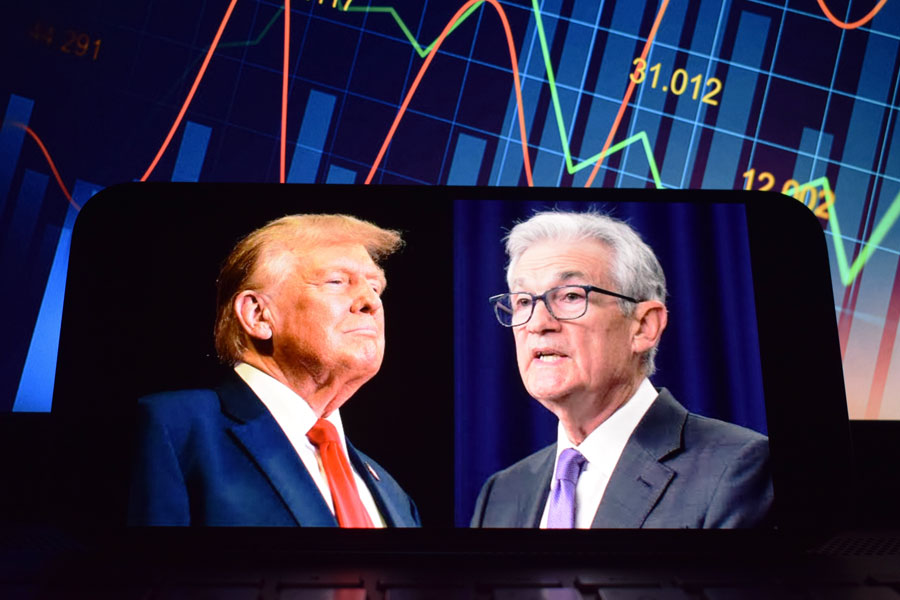
WASHINGTON, D.C. – In a rare and highly publicized visit to the Federal Reserve’s headquarters on Thursday, President Donald Trump intensified his campaign for interest rate cuts, personally confronting Fed Chair Jerome Powell in front of cameras during a tour of the agency’s $2.5 billion renovation project.
The visit marked the first time in nearly two decades that a sitting U.S. president has appeared at the Federal Reserve’s main building, underscoring the growing tensions between the executive branch and the central bank as the country navigates persistent inflation pressures, a softening housing market, and stagnating wage growth.
Trump used the occasion not only to tour the facility – urrently undergoing a controversial and expensive renovation – but also to criticize the project’s cost and link it directly to what he sees as Powell’s broader mismanagement of the economy. Standing near construction crews and flanked by aides, Trump claimed the cost of the project had ballooned to $3.1 billion, accusing the Fed of wasteful spending and questioning whether Powell could be trusted to oversee monetary policy responsibly.
Powell pushed back, clarifying that Trump’s figure combined current construction costs with completed upgrades from a separate facility. Despite the tension, both men remained publicly civil, though the subtext of the visit was clear: Trump is putting the full weight of the presidency behind a campaign to lower interest rates ahead of the 2026 economic cycle.
The president, who has a long history of criticizing Powell, stopped short of demanding his resignation but floated the idea in front of reporters. “If this were one of my buildings,” Trump said, “I’d fire the project manager.” He quickly added that he had no immediate plans to remove Powell but would be watching closely for results.
The exchange added fuel to what has become a high-stakes political and economic drama. Trump has made it clear he believes high interest rates are holding back the U.S. economy, particularly in the housing sector. Mortgage rates remain elevated, home sales have slowed, and affordability has become a major concern for voters heading into the next election cycle.
The Fed, for its part, has held its benchmark rate between 4.25% and 4.50%, citing lingering inflation concerns and a desire not to prematurely stimulate demand. Powell and other Fed officials have signaled a cautious approach to rate changes, even as some indicators – such as cooling consumer spending and softening labor demand – suggest the economy may be ready for a cut.
Inside the Fed, sources say there is division. Trump-era appointees, such as governors Michelle Bowman and Christopher Waller, are reportedly open to a rate cut as early as September, while more hawkish members are urging patience. Trump’s public pressure campaign could further polarize this debate, raising questions about the Fed’s independence and its ability to act free from political influence.
Market analysts are divided on whether Trump’s tactics will work. Some see it as a strategic play to rally populist support around economic relief, while others warn that it risks undermining investor confidence in the central bank. Still, there’s no question that the visit was a carefully timed and deliberate show of force – one that raises the stakes for Powell, the Fed board, and the broader economy in the weeks ahead.
Trump, Fed Chair Powell clash on camera over Fed HQ renovation costs
What Happens If the Federal Reserve Lowers Interest Rates? Top Questions Answered
Q1: What does it mean when the Fed lowers interest rates?
A: When the Federal Reserve cuts rates, it lowers the federal funds rate – the benchmark interest rate banks use to lend to each other. This reduction trickles down to consumers and businesses, making borrowing cheaper across the board.
Q2: How will lower interest rates affect mortgage rates?
A: Mortgage rates often follow the Fed’s direction, though not always immediately. A rate cut usually results in lower mortgage rates, making it more affordable for homebuyers to purchase property or refinance existing loans.
Q3: Will home prices go up or down?
A: Lower mortgage rates tend to boost demand in the housing market, which can push home prices higher. If the supply of homes remains tight, price increases may accelerate.
Q4: What does it mean for credit cards, car loans, and personal loans?
A: Variable-rate products like credit cards and some auto or personal loans typically become less expensive. Consumers may see lower interest charges and monthly payments.
Q5: How will this affect savings accounts and CDs?
A: Savers usually take a hit. Banks tend to lower interest rates on savings accounts, money market funds, and CDs, making it harder to earn returns on safe investments.
Q6: Is this good or bad for the stock market?
A: Investors often view rate cuts positively. Lower borrowing costs can boost corporate profits, and cheaper money can drive more investing. Stocks — especially in real estate, tech, and consumer goods — often rally after a rate cut.
Q7: Could this lead to inflation?
A: If rate cuts stimulate demand too quickly, inflation could rise again. However, the Fed typically cuts rates only after inflation is under control or if there’s concern about economic slowdown.
Q8: How might this impact the economy as a whole?
A: A rate cut can stimulate economic growth by encouraging spending, investing, and hiring. But if overused, it can overheat the economy or create bubbles in housing or equities.
Q9: What does it mean for the value of the U.S. dollar?
A: Lower interest rates often weaken the dollar because global investors seek higher returns elsewhere. A weaker dollar can help U.S. exporters but may raise the cost of imports.
Q10: When could this happen?
A: While no decision has been made yet, analysts believe the Fed may cut rates later this year — possibly as early as September 2025, depending on inflation, job growth, and market conditions.


